How Does Dissolved Oxygen Get Into Water
- Overview
- When to List
- Ways to Measure
- Conceptual Diagrams
- References
Overview
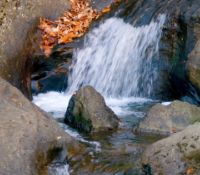
On this Folio
- Checklist of Sources, Site Bear witness and Biological Effects
- Consider Listing Dissolved Oxygen as a Candidate Cause
- Consider Contributing, Modifying and Related Factors every bit Candidate Causes
- Consider Not List (Eliminating) Dissolved Oxygen equally a Candidate Cause
Dissolved oxygen (DO) refers to the concentration of oxygen gas incorporated in water. Oxygen enters water by direct absorption from the temper, which is enhanced past turbulence (see Figure 1).
Water also absorbs oxygen released by aquatic plants during photosynthesis. Sufficient DO is essential to growth and reproduction of aerobic aquatic life (e.g., run into Spud 2006, Giller and Malmqvist 1998, Allan 1995). This module provides advice for deciding whether to include depleted or (less ordinarily) excessive DO as a candidate crusade.
Checklist of Sources, Site Bear witness and Biological Furnishings
This module addresses low or excessive DO every bit a proximate stressor. Practice should exist a candidate crusade when potential human sources and activities, site observations or observed effects support portions of the source-to-damage pathways (meet Effigy 2).
The checklist beneath will assistance you identify key data and information useful for determining whether to include DO among your candidate causes. The list is intended to guide you in collecting evidence to back up, weaken or eliminate DO as a candidate cause.
For more than information on specific entries, go to the When to List tab.
Consider listing Practice every bit a candidate crusade when the following sources and activities, site evidence and biological effects are present:
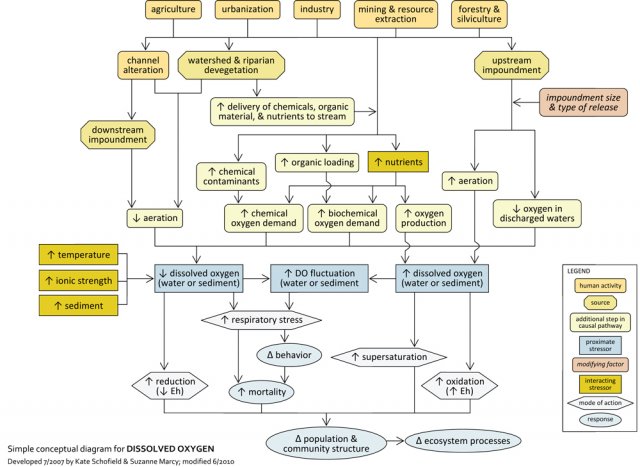
Sources and Activities
- Impoundments
- Municipal waste product handling outfalls
- Industrial point sources
- Agronomical and urban runoff
- Removal of riparian vegetation
- Aqueduct alteration
- Groundwater inflow
Site Evidence
- Loftier plant affluence
- Slow-moving water
- Reduced water volume
- Weather conditions, season, fourth dimension of day
- High height
- Presence of organic waste material
- Turbid h2o
- Foul smelling water
- Yellowish-green, brown, gray or black water or dark sediments
- Embedded substrate
Biological Effects
- Kills of aquatic life
- Big fish dice earlier pocket-size fish
- Species requiring greater concentrations of DO die first
- Characteristic body movements
- Fish gulping air
- High Hilsenhoff Biotic Index (HBI) score
- Replacement of Practise sensitive species with fly larvae and worms
Consider contributing, modifying and related factors equally candidate causes when Practice is selected every bit a candidate cause:
- Temperature: High temperatures reduce the solubility of oxygen in water (i.eastward., warm h2o holds less Do than cold h2o).
- Nutrients: High nutrients tin can atomic number 82 to excessive plant growth, resulting in Do declines due to respiration and decomposition.
- Sediments: Embedded sediments can prevent Exercise from permeating interstitial areas.
- Ammonia: Oxygen is consumed as ammonia is oxidized (nitrification), and low oxygen levels increase ammonia levels by inhibiting nitrification.
Consider not listing (eliminating) low DO as a candidate crusade when y'all have evidence from your site about turbulence and DO:
- Loftier turbulence at the site creates consistent aeration (implausible mechanism).
- Concentrations measured continuously over fourth dimension at the site are the aforementioned equally or greater than concentrations at sites without observed biological impairment (lack of co-occurrence).
When to List
- Sources and Activities that Suggest Listing DO every bit a Candidate Crusade
- Site Evidence that Suggests Listing DO as a Candidate Cause
- Biological Effects that Propose Listing Do as a Candidate Cause
- Site Show that Supports Excluding Practise as a Candidate Cause
Sources and Activities that Suggest Listing Do as a Candidate Cause
The corporeality of dissolved oxygen (Practice) in surface waters is influenced by numerous human activities, both in waterbodies and in their associated watersheds. The more extensive the relevant sources and activities, the more likely low Do will impair surface waters.
Impoundments: Impounding water may elevate or depress downstream Practice, depending on impoundment design and performance. If water is released from the top of an impoundment or dam, the water may be warmer and thus less able to concur oxygen, but the large impoundment expanse and increased turbulence over a spillway and downstream may enhance aeration. Water released from the bottom of a dam is frequently cooler (i.e., DO saturation is college), but oxygen deficits may occur in these deeper reservoir waters. Upstream of dams, water is moving more slowly and Do may be low in subsurface waters from lack of turbulence and, at greater depths, from lack of low-cal for photosynthesis.
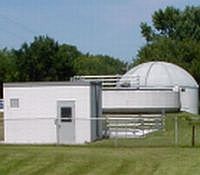
Municipal waste treatment plants: Municipal waste treatment plants (also referred to as public-owned treatment works, or POTWs; run across Figure iii) process municipal wastewater, and are operated under permit limits designed to protect receiving waterbodies from excess inputs of nutrients and organic thing. However, during storms, excess menstruum may be diverted into combined sewer overflows (CSOs) that deposit untreated municipal waste directly into streams. Episodic treatment failures also may occur.
Septic seepage and failed parcel plants: Seepage from failed septic tanks or their leach fields and emissions from poorly operation package sewage treatment plants may contribute significant amounts of nutrients and organic matter, creating biological oxygen demand (BOD).
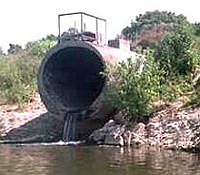
Industrial point sources: Some industries release organic chemicals that require oxygen for decomposition. These terminate-of-pipe discharges (see Figure 4) are regulated under permit limits to protect receiving waterbodies. However, in cases where the original organization blueprint is not acceptable, or issues in operation lead to inadequately treated discharges, oxygen depletion may result.
Agronomical and urban runoff: Food runoff from agricultural or residential fertilizer applications (come across Figures 5 and 6) tin can increment the corporeality of algae and macrophytes in water. This in turn can lead to both higher oxygen inputs during the solar day and increasing oxygen demands from respiration at night. When plants die, they are decomposed past bacteria and fungi that consume oxygen. Organic affair washed into streams from animal wastes or landfills as well tin can increase oxygen demand.
Devegetated riparian areas: Removing vegetation from the banks of surface waters (come across Figure 7) increases surface h2o runoff and decreases shading. Decreased shading increases h2o temperatures and institute production. Higher temperatures decrease the solubility of oxygen in water. Found production increases DO in daylight hours just increases oxygen demand during the night. Subsequent plant decomposition can deplete Exercise. In addition, reduced turbulence from less woody debris may decrease aeration.
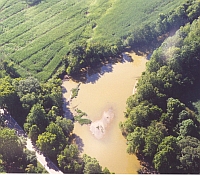
Channel alteration: Stream channel straightening (see Figure 7) often reduces turbulence by removing structural diversity and alters curves and riffles. This may deepen the channel, reducing the surface-to-volume ratio and thus improvidence and aeration. Natural inflows of groundwater normally have low concentrations of Exercise and may at first lower Practice concentration in surface waters. However, groundwater is often colder than surface water and may increase DO saturation levels. Changes to local hydrology and surface water temperatures may shift the effect of groundwater inflow on DO.
Site Evidence that Suggests Listing Do equally a Candidate Cause
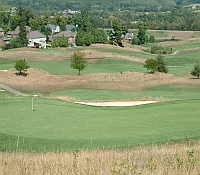
In add-on to observations of sources discussed above, observational evidence suggesting that low Practice should be included as a potential candidate cause includes the following:
High plant abundance: Large amounts of algae (in the water column or on solid substrates) or aquatic vascular plants suggest the possibility of low DO, due to high found respiration at dark and loftier oxygen demand for decomposition of plant detritus. When plant abundance, temperatures, and light levels are high and turbulence is depression, Practice supersaturation may occur during the day, with decreased Exercise at night.
Boring-moving water: Very slow-moving or however water (see Figure 8) may accept depression DO because of lack of turbulent aeration. In addition, slow-moving water tends to warm, reducing saturation levels for DO in the water cavalcade. Slow currents likewise may hamper delivery of oxygen to organisms.
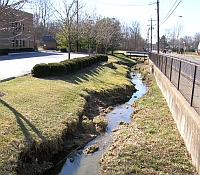
Reduced water volume: Reduced h2o volume tin can concentrate fish into pools or other refugia where respiration exceeds oxygen renewal. H2o volume can be reduced by removal for irrigation or other uses, by seasonal changes in rainfall, or by loss of suitable habitat due to episodic pollution, temperature increases or other factors.
Weather conditions, seasons, time of mean solar day: Colder water saturates at higher Practise levels than warmer h2o, and then DO concentrations at a specific location are usually higher in winter than summer. During dry seasons, water levels decrease and stream flows turn down, warming water and reducing turbulent mixing with air. During rainy seasons, oxygen concentrations tend to rising in most surface waters considering pelting saturates with oxygen every bit information technology falls. More sunlight and warmer temperatures too increment plant growth and animal activeness, which may increase or decrease DO concentrations and increase diurnal fluctuation. Weather atmospheric condition fostering oxygen depletion include long periods of calm sunny weather that promote extensive algal growth, followed by cloudy days and nights when respiring plants eat more than oxygen than they produce. DO concentrations tend to exist everyman just before dawn.
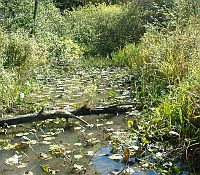
Courtesy of Jeff Varrichione, Maine DEP
Presence of organic wastes: Organic wastes are the remains of any living or in one case-living organism (e.g., dead plants or animals, leaves, animal droppings, sewage). Such organic thing observed within or being released to a waterbody suggests low Do every bit a candidate crusade considering organic decomposition consumes oxygen. Excessive organic wastes in water may result in a grayish bandage with visible sludge deposits in depositional areas.
Turbidity: Turbidity tin can limit photosynthesis and may exist due in part to suspended organic matter which creates biological oxygen demand.
Bad olfactory property: Water smelling like rotten eggs or sour cabbage can indicate the presence of low oxygen atmospheric condition.
Color: The colour of water that is depression in oxygen may change from light greenish to pea-soup green, brownish, gray or black. Dark sediments due to metal sulfides indicate anoxic conditions.
Embedded substrate: When rocky substrates become embedded with fine sediments, benthic organisms may be affected by low interstitial Practice concentrations.
Biological Effects that Propose Listing Practice every bit a Candidate Cause
Oxygen is essential to aquatic plants, animals, and aerobic microbes. Aquatic creature obtain oxygen by actively moving water across their respiratory structures or by passively assuasive currents to deliver oxygen to them. Some organisms require nearly saturated levels of oxygen (due east.m., salmonids, riffle invertebrates), whereas others tin tolerate very low Exercise levels (east.one thousand., channel catfish) (for overviews, see Irish potato 2006, Giller and Malmqvist 1998, Allan 1995, Nebeker 1972).
Consider suboptimal DO as a candidate cause when you see changes in aquatic community structure or acute biotic effects every bit described below. Please note, all the same, that observations of these effects practise non confirm a causal relationship. In some cases the same observed effect could be caused by other stressors or multiple agents. If yous suspect DO as the crusade of observed biological impairments, then also consider temperature and sediments, stressors often associated with and contributing to low Do. If nutrients or organic matter are parts of the causal pathway leading to depression DO, so excess found growth, ammonia and pathogens also may be of concern.
Changes in aquatic customs structure: Decreases in DO levels tin can cause changes in the types and numbers of aquatic macroinvertebrates in surface waters. Species that are intolerant of low DO include some species of mayflies, stoneflies, caddisflies and beetles. As DO concentrations subtract, these organisms often are replaced past tolerant worms and fly larvae. The Hilsenhoff Biotic Index (HBI) is a biotic index based on species tolerances to organic enrichment (Hilsenhoff 1987, Hilsenhoff 1982); high HBI scores may signal organic enrichment sufficient to decrease oxygen levels. Fish communities also change with Practise, but the patterns are not as clear because of fewer species and a smaller range of tolerance.
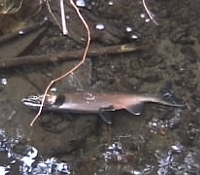
Courtesy of NOAA
Astute effects of low Exercise: Biological furnishings and environmental changes associated with oxygen depletion may include the following (Meyer and Barclay 1990):
- Kills of aquatic life (see Figure 9) occurring abruptly in early morn, unremarkably betwixt 0200 hrs and sunrise. If the kill is incomplete, it usually subsides soon afterward sunrise but may resume the following night.
- Kills of aquatic life occurring on cloudy days preceded by several warm sunny days.
- Large fish of a given species dice first, whereas minor fish may be alive.
- Species with the highest oxygen requirements die, whereas other species are not equally significantly afflicted.
- Body movements to increment h2o menses may be observed in certain macroinvertebrates (due east.m., some stonefly larvae exercise "push-ups", some caddisfly larvae undulate).
- Fish gulp air at the water surface and stay in shallow h2o.
- Decaying vegetation may be abundant, or many dead and dying algae may be detected nether a microscope.
- Zooplankters are expressionless or dying.
Astute effects of oxygen supersaturation: When aquatic plants are arable and weather conditions are platonic for photosynthesis, plants may supersaturate the water with oxygen. If the water temperature rises or if the pressure changes chop-chop, fish in the expanse may develop oxygen-related gas bubble disease (Meyer and Barclay 1990). In fish with gas chimera disease, bubbles or emboli block the menstruum of blood through blood vessels, causing death. In fish dying from this disorder, external bubbles (emphysema) may be seen on fins, peel, around the optics or on other tissues. Aquatic invertebrates also are affected past gas bubble affliction, merely at levels higher than those lethal to fish. Other gasses can result in similar effects so farther investigation is needed.
Site Evidence that Supports Excluding DO as a Candidate Crusade
Communication on excluding low DO as a candidate cause is limited to situations in which the physical characteristics of a site enhance Exercise or when low DO cannot logically account for the damage. Thus, unambiguous sources and site observations can be used to eliminate Exercise as a candidate cause. Biological evidence should not be used to exclude DO since several stressors alone or combined may cause like symptoms of depression or loftier Practice. Further investigation volition exist needed. This type of initial screening saves fourth dimension but when unnecessary listing of candidate causes is avoided. Early on screenings should be conservative because the premature emptying of an bodily crusade will increment the time and cost of stressor identification.
Sources: Low concentrations of DO are physically precluded past consistent aeration from turbulence. Spillways, waterfalls, and turbulent flows in streams and rivers naturally aerate h2o. Still, if flow changes during part of the twelvemonth, Exercise will be affected and this should be considered. Potent wave activeness in marine coastal areas may ensure aeration, whereas gentle moving ridge action and riffles may or may not exist sufficient, depending on the depth of the water and rigor of mixing. Screening in these situations should be complemented with measures of DO concentrations (see Ways to Measure out tab).
When non listing depression Do as a candidate cause due to turbulence, consider listing contradistinct hydrologic menses or bereft sediment retention or supply. Both are known to occur below spillways and waterfalls due to retentiveness of sediment backside the dam, and the power of water turbulence beneath the dam that can remove sediment and dislodge organisms.
Site observations: When continuous measures of Do are available that document diurnal patterns over a long menstruum of time, and they show DO concentrations consistent with those found at unimpaired sites, you may choose not to list low DO (lack of spatial co-occurrence). Nevertheless, we strongly caution against using benchmarks of effects for excluding DO from your initial listing of candidate causes, because different species have different oxygen requirements (e.g., some mayflies exhibit effects at nine mg/Fifty, which is well higher up the U.S. EPA standard of five mg/L; U.S.EPA 1986).
Ways to Measure out
The concentration of oxygen in water is oft reported either as the concentration in mg/L or as the percent saturation. Exercise concentrations and percent saturation are related, just non equivalent. Saturation level varies naturally, as h2o tin incorporate more Practice at lower temperatures, higher pressures, and lower salinities. For example, 100% saturation occurs at low oxygen concentrations at high elevations compared to depression elevations (Hem 1985).
The Winkler titration procedure was the first recognized method for determining DO concentrations in natural waters (Winkler 1988, cited in Mitchell 2005). More than recently, this method was found prone to over-reporting Practice nether hypoxic conditions and nether-reporting DO under most anoxic weather. Fairly uncomplicated and reliable Practise measurements now can be obtained with DO meters or field examination kits. The electronic meter does not measure oxygen direct; rather, it uses electrodes to measure the fractional pressure of oxygen in the h2o, expressed every bit a concentration (commonly mg/Fifty of water) [see APHA (1998), Mitchell and Stapp (1992), and USGS (1998)]. Percent saturation is calculated past dividing the measured Do concentration past the saturation level and multiplying by 100. Saturation levels tin be obtained from U.Due south. Geological Survey solubility tables based on water temperature and corrected for different salinities and pressures.
Equations for computing percent saturation are available from H2o on the Spider web.
Biochemical oxygen demand (BOD) and chemical oxygen need (COD) are measures of the potential consumption of oxygen by microbial respiration and the oxidation of chemicals in the water, respectively. The actual rate of oxygen consumption in a stream is afflicted by a number of variables including temperature, pH, the presence of certain kinds of microorganisms, and the blazon of organic and inorganic material in the water.
The lowest concentrations of Practise are unremarkably measured before photosynthesis begins for the day (i.eastward., just before dawn), and just above the sediments, where well-nigh decomposition occurs. Documentation of DO concentrations over a 24-hour period may be useful for identifying diurnal patterns and may reveal information about Exercise depletion.
Conceptual Diagrams
- Well-nigh Conceptual Diagrams
- Simple Conceptual Model Diagram
- Detailed Conceptual Model Diagram
About Conceptual Diagrams
Conceptual diagrams are used to depict hypothesized relationships among sources, stressors and biotic responses within aquatic systems.
- More than nigh Conceptual Diagrams
Unproblematic Conceptual Model Diagram

Aerobic aquatic life requires oxygen for survival, and about are dependent upon oxygen dissolved in the water cavalcade (see Figure 10). Dissolved oxygen (Do) concentrations are normally sufficient to maintain good for you biotic assemblages in unpolluted, free-flowing streams, but low or extremely loftier Practise levels can impair or kill fishes and invertebrates. In addition, large fluctuations in Practice levels over relatively brusk periods of time (e.m., daily) can stress aquatic organisms.
Human activities can significantly affect DO concentrations in streams, most notably by decreasing oxygenation and by increasing chemical or biochemical oxygen demand. Agricultural practices, forestry practices, and other activities may involve channel alteration (due east.one thousand., straightening or deepening of streams) or impoundments downstream of a location, which may decrease aeration and the diffusion of oxygen into water. Impoundments upstream of a location may discharge low oxygen water downstream, but releases also may increase turbulence and oxygenate water.
These state use practices also may directly introduce nutrients (e.g., fertilizers, fauna wastes), chemical contaminants (eastward.grand., heavy metals), or organic thing (due east.g., sewage, animal wastes) to streams, or indirectly increment the delivery of these substances to streams via land encompass alteration. The resulting chemical reactions and increased respiration of microbes and plants can increment oxygen demand in streams, leading to decreases in Exercise.
These sources also may affect Practise via interactions with other stressors. For example, Practice saturation occurs at lower concentrations in warm versus cold h2o, so factors contributing to increased h2o temperatures (e.thou., loss of riparian encompass, warm effluents) may contribute to decreased Do concentrations. Similar relationships are seen with increasing ionic strength and sediment.
Although most impairments associated with DO upshot from insufficient oxygen levels, in rare cases DO concentrations may be too high (e.thousand., due to increased photosynthesis and subsequent oxygen production in nutrient-enriched streams. Even if elevated Do levels do not crusade directly impairment, they may contribute to stressful DO fluctuations when followed by significant drops in Practice at night.
Detailed Conceptual Model Diagram
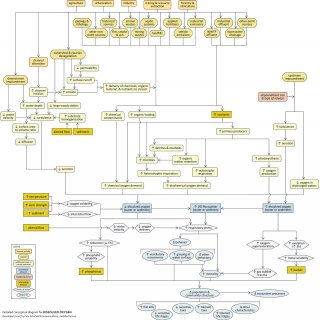
Aerobic aquatic life requires oxygen for survival, and almost are dependent upon oxygen dissolved in the water cavalcade. Dissolved oxygen (DO) concentrations are usually sufficient to maintain healthy biotic assemblages in unpolluted, complimentary-flowing streams, but low or extremely loftier Do levels can impair aquatic communities.
This conceptual diagram (Effigy 11) illustrates linkages between DO-related stressors (center of diagram), the human being activities and sources that consequence in those stressors (top of diagram), and the biological responses that can result (bottom of diagram). In some cases, additional steps leading from sources to stressors, modes of action leading from stressors to responses, and other modifying factors also are shown. This narrative generally follows the diagram top to bottom, left to correct.
Linking Sources and Activities to Proximate Stressors
Certain man activities, such as agronomical, residential, and industrial practices, tin can contribute to DO depletion (or, less frequently, DO supersaturation) and subsequent biological impairment. These practices may straight introduce chemical contaminants, organic loading, and nutrients to streams, via point and non-bespeak sources (e.yard., wastewater treatment plant effluents, fertilizers, fauna wastes, landfills, septic systems). Increases in these substances can increase chemical and biochemical oxygen demand, most notably due to increased respiration of plants and microbes.
Physical amending of the stream aqueduct, through impoundments or channel alterations, can contribute to depression dissolved oxygen concentrations in several means. For example, an impoundment downstream of a location will deadening h2o velocities and increment water depths, which will tend to reduce turbulence and lower incorporation of oxygen into the water column via aeration, as well as reduce improvidence of oxygen from the atmosphere.
Channel incision also reduces oxygen diffusion due to decreases in surface-to-volume ratio with increasing stream depth. An impoundment upstream of a location (upper far right of diagram) may reduce Practise levels if downstream water releases come from deeper, oxygen-depleted waters of the reservoir (i.due east., if they are hypolimnetic), simply may increase Do levels if discharges are highly turbulent; whether DO levels increase or subtract volition depend on impoundment size and type of release.
Land cover alterations also may reduce stream DO levels by altering in-stream physical characteristics. For example, decreases in riparian vegetation often associated with these activities can reduce big woody debris inputs to the channel, reducing turbulence and aeration; homogenization of stream substrates tin accept similar effects. In add-on these alterations may increase delivery of chemic contaminants, organic material, and nutrients to streams with surface runoff.
DO concentrations are also closely linked to several other stressors. Interactions betwixt nutrient concentrations and Exercise were mentioned before—basically, food enrichment stimulates oxygen-generating (photosynthesis) and oxygen-depleting (respiration) processes.
In addition, DO levels are affected past water temperature, ionic strength, and dissolved solids: oxygen solubility decreases equally these parameters increase, reducing the amount of DO in the h2o. Increased bedded sediment tin decrease interstitial menstruation, reducing oxygen availability for sediment-dwelling organisms; decreases in water velocity can lower oxygen delivery rates.
Linking Proximate Stressors to Biological Responses
Exercise concentrations straight impact abiotic and biotic stream environments. Low Do (blue rectangle, eye) affects the oxidation and reduction (redox) reactions which determine the bioavailability of many inorganic compounds, every bit well every bit biologically of import materials such as nitrogen and sulfur.
For instance, lower redox potential (Eh) may decrease the release of precipitated metals, which actually may benefit organisms past reducing bioavailability. Notwithstanding, it also may increment the release of precipitated phosphates, encouraging the proliferation of nitrogen-fixing cyanobacteria and potentially altering food resources for fish and invertebrate assemblages.
The near directly effect of low DO is respiratory distress in biota, which may exist exacerbated by relatively rapid fluctuations in bachelor DO. During periods of low DO, some species may increase movement to enhance ventilation across gill structures, try to gulp air from the surface, or get together around photosynthesizing plants.
Respiratory stress tin cause low Practice-sensitive taxa [e.g., EPT taxa, or Ephemeroptera (mayflies), Plecoptera (stoneflies) and Trichoptera (caddisflies); salmonid fishes] to decrease. Decreases in depression Practice-sensitive life stages also are potential indicators.
Conversely, more tolerant organisms (e.grand., cyprinids, amphipods, and chironomids with hemoglobin) and life stages may increase. Increased populations of plant-breathers (e.g., insects that tin can obtain air from plants, such as sure protrude larvae) and air-breathers (e.grand., insects that tin can carry air bubbles with them underwater) as well may be observed. If DO depletion is significant enough, widespread fish kills may occur.
Although biological impairments related to dissolved oxygen usually result from insufficient DO levels, too much Exercise, or supersaturation, too may pose a problem in certain situations. This supersaturation may result from extremely high levels of oxygen-generating photosynthesis, or from extremely high turbulence and aeration downstream of impoundments.
Ultimately, these rapid or large increases in DO may affect organisms past contributing to stressful fluctuations in Practise levels, altering redox potentials and bioavailability of potentially toxic substances (e.thousand., metals), or leading to gas bubble illness (a status indicated by gas bubbles forming nether peel and around eyes).
References
- Allan JD (1995) Stream Ecology: Construction and Role of Running Waters. Chapman & Hall, London United kingdom.
- APHA (American Public Health Association); AWWA (American Water Works Association); WEF (H2o Environment Federation) (1998) Standard Methods for the Exam of H2o and Wastewater (20th edition). American Public Health Association, Washington DC.
- Giller PS, Malmqvist B (1998) The Biological science of Streams and Rivers. Oxford University Press, London United kingdom of great britain and northern ireland.
- Hem JD (1985) Study and Interpretation of the Chemical Characteristics of Natural H2o (3rd edition). U.S. Geological Survey, Water Supply Paper 2254.
- Hilsenhoff WL (1982) Using a biotic index of to evaluate h2o quality in streams. Wisconsin Section of Natural Resources, Technical Message No. 132. 22 pp.
- Hilsenhoff WL (1987) An improved biotic index of organic stream pollution. Great Lakes Entomologist 20:31-39.
- Meyer FP, Barclay LA (1990) Field Manual for the Investigation of Fish Kills. U.S. Fish and Wild animals Service, Washington DC. Resource Publication 177.
- Mitchell MK, Stapp Westward (1992) Field manual for water quality monitoring (5th edition). Thomson Shore Printers, Dexter MI.
- Mitchell TO (2007) Brilliance based measurement of dissolved oxygen in natural waters. Hach Ecology.
- Murphy S (2006) Boulder Expanse Sustainability Information Network website
- Nebeker AV (1972) Effect of depression oxygen concentration on survival and emergence of aquatic insects. Transactions of the American Fisheries Society 4:675-679.
- U.S. EPA (1986) Ambient Water Quality Criteria for Dissolved Oxygen. U.S. Ecology Protection Bureau, Role of H2o, Washington DC. EPA/PB86-208253.
- USGS (1998) National field manual for the collection of water-quality information. U.Due south. Geological Survey, Techniques of Water-Resources Investigations. Book 9, Chapters A1-A9.
Contacts: Authors & Contributors
How Does Dissolved Oxygen Get Into Water,
Source: https://www.epa.gov/caddis-vol2/dissolved-oxygen
Posted by: hobgoodplas1968.blogspot.com


0 Response to "How Does Dissolved Oxygen Get Into Water"
Post a Comment